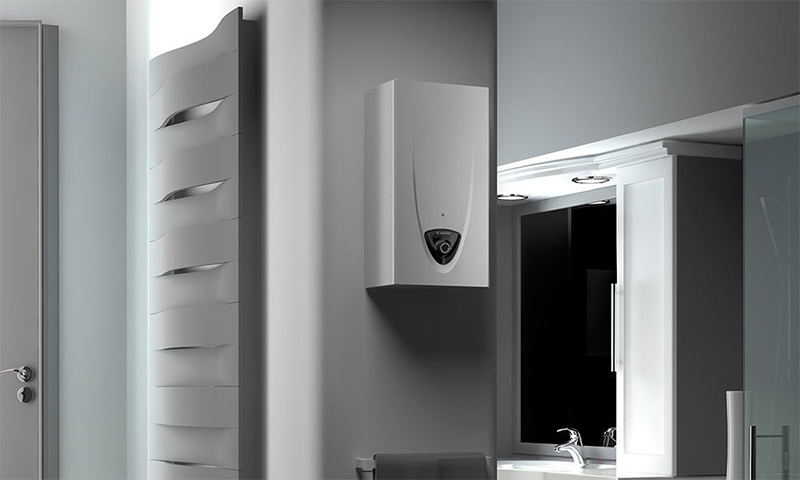It is no secret that for one reason or another, the user is often left without hot water for a short or long term. The problem in such cases is solved simply - the water heater is bought and installed. But to choose this necessary device among the variety of models is much more difficult - there are many of them, and there are even more differences between them. The devices differ: type of energy carrier and method of heating; power and performance; dimensions and method of installation, materials of manufacture and cost. In addition, some are more suitable for the home, others for the apartment, and others for the dacha. After reading the article, the choice will be much easier.

Content:
The best manufacturers of water heaters - which company to choose
Based on different criteria, there are many water heaters, and they are created by manufacturers, of which there are a large number on the market.
Attention users are offered some of the best companies that have earned the trust of customers for their high-quality products:
1. Electrolux
2. Timberk
3. Baxi
4. Bosch
5. Gorenje
Types of water heaters
Electric water heaters
Devices for water heating, working on electricity, are divided among themselves according to different parameters - according to the design and the principle of operation, they are flow-accumulative, flow-through and accumulative.
Accumulative

Cylindrical and rectangular shapes are produced, mounted vertically and horizontally, fastened to the wall and installed on the floor - the practical volume of the tank ranges from 10 to 300 and more liters.
The structure includes: a case, a heater, a magnesium anode, branch pipes, fittings, as well as a control and monitoring unit. The tank is a thermos consisting of an external casing, mainly polyurethane foam insulation and an internal container, which is created from stainless steel, plastic or sheet steel with enamel, glass porcelain, or titanium coating. Heating elements are installed in an amount from 1 to several pieces in “wet” (contact with water) or “dry” (insulating flask is used) versions.
During operation: the boiler from the cold water supply system is filled with water; TEN is connected to the mains voltage of 220 V; the handle sets the desired temperature - from 50 to 90 ° C. Upon reaching the required level of heating, the stability of the mode is ensured by the use of a thermostat - a visual inspection is carried out by means of an integrated thermometer.
In the presence of an automation system with an LCD monitor, manipulations are performed on the display - the set water temperature is maintained with a deviation of no more than 0.5 ... 1.0 ° C, power is only 1.0 ... 2.5 kW. Depending on the volume of the tank, water heats up from 0.5 to several hours and is supplied to the n-th number of collapsible points. In the course of operation, approximately every 1.5 years, the anode changes, performing internal corrosion protection.
Advantages of electric storage water heaters:
- possibility of simultaneous provision of several water points;
- low power consumption;
- very slow cooling of hot water;
- H2O temperature stability during feeding;
- ease of use;
- wide selection.
Disadvantages:
- large size and the inconvenience associated with this factor;
- considerable time of heating a new portion of fluid.
- See also: best storage water heaters
Flow through
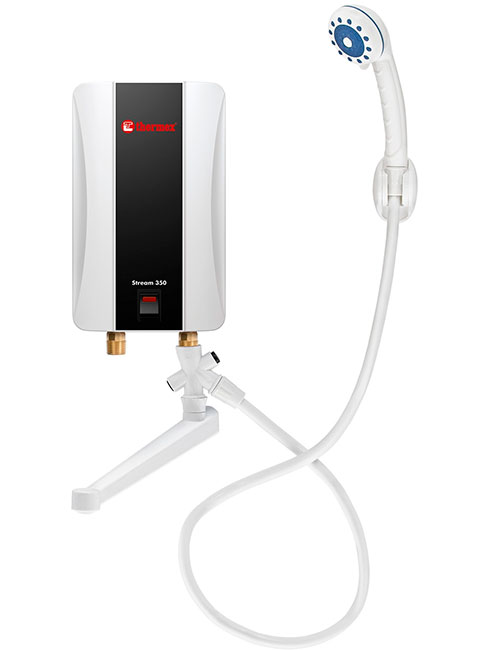
Water heater flow type is significantly different from cumulative.It is a small-sized device consisting of a housing, a powerful heating element, a pressure switch, a temperature controller, a ground terminal, a switch, and inlet and outlet pipes.
When you open the tap, unlike the previous model, the water is instantly heated and supplied to the user. These products have 2 subspecies: free-flow, which serve only 1 parsing point and, as a rule, are installed next to it; pressure, capable, due to high power and significant pressure in the centralized HV network, to supply simultaneously to several plumbing fixtures, for example, to the sink, to the sink and to the shower.
If in the first case, where the power of the device is 3.5 ... 8.0 kW, you can do with the existing wiring with voltage of 220 V, then in the second variant, with a possible 27.0 kW, you need to lay a separate three-phase (380 V) line.
The advantages of electric instantaneous water heaters:
- the possibility of continuous filing;
- use of electricity only when water consumption;
- lack of influence of the hull material on performance;
- small size and easy installation;
- ease of use and a wide range.
Disadvantages:
- large peak electricity consumption;
- the need for additional wiring;
- dependence of output water temperature on input.
- See also: best instantaneous water heaters
Flow Accumulative

Instantaneous storage water heater is a hybrid device, which constructively combines the above 2 models. It has a small boiler mainly with a volume of 10 ... 30 l and an integrated flow-through unit. With a small consumption, a storage tank with a heating element with a power of ≈ 2.5 kW is used - with a continuous supply, a heating element with a power consumption of about 20 kW is operated. The scheme of functioning can be both pressure head, and free-flow.
The modification has all the advantages of a flow-through and a cumulative version - relatively small size, mostly stable temperature, provision of several points with water at once, rapid heating, ease of use and simple installation.
At the same time, there were also joint defects, in addition, such instances are rarely found on sale.
Gas water heaters
Devices that heat water with gas are also cumulative and flow-through.
Accumulative
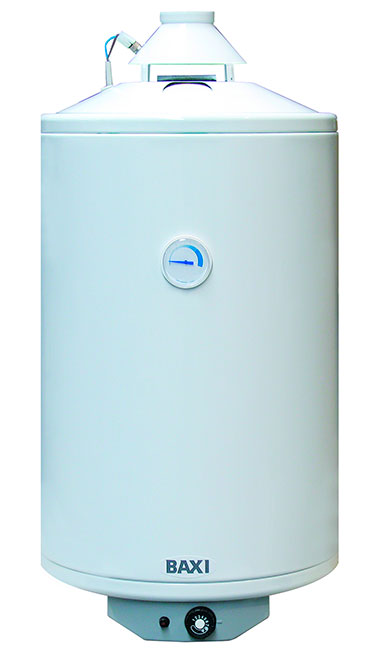
Cumulative in many respects similar to electrical counterparts. Structure structure: insulated tank with internal anti-corrosion coating (with V ≤ 120 l - hangs on the wall, with V ≥ 150 l - is installed on the floor); magnesium anode; tube for entry and exit of hot and cold water; burner N = 4 ... 9 kW; gas duct with smoke breakers; exhaust hood; control unit.
At start-up: the boiler is filled with water; using electric or piezo ignition, the burner is turned on; heating, which is carried out through a heat exchanger, stops when the liquid reaches a predetermined temperature. If the fuel chamber is open type, the products of combustion are removed through the chimney, if - closed, - forcibly through a coaxial pipe.
For safe operation, the system is equipped with a draft sensor, a hydraulic valve and a flame controller, which shut off the gas at various deviations in operation.
Advantages of gas storage water heaters:
- relatively cheap energy carrier;
- the ability to provide water with many points of analysis;
- fast heating compared to an electric boiler;
- no temperature drops of the water supplied;
- slow cooling of H2O in the tank;
- ease of use.
Disadvantages:
- slow heating, when compared with the column;
- with an open combustion chamber to build a chimney;
- high cost of boiler and installation.
Flow through
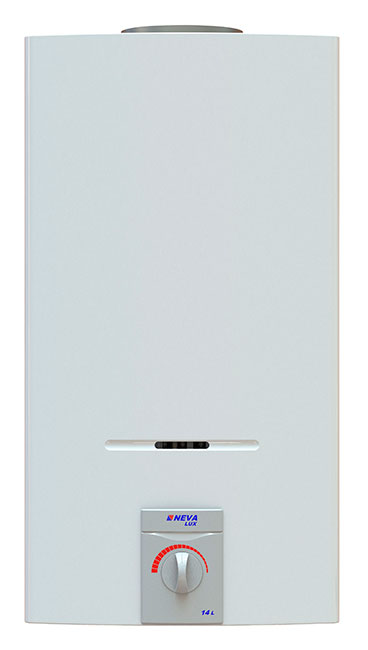
In the flow model, unlike the cumulative version, water does not contact with the external walls of the tank and does not linger for a long time in the apparatus.
The construction includes: a small rectangular case, which is vertically attached to the wall; predominantly modulated burner; tubular heat exchanger; inlet and outlet connections; smoke output; safety devices; control unit and management.
To turn on the column, the button is pressed or the valve is immediately opened; as a result, the burner from the piezoelectric, electric or hydro ignition ignites, which heats the water through a heat exchanger. Removal of combustion products is carried out similarly to the cumulative option.
Depending on the required performance, the device is installed with low (11 ... 19 kW), medium (21 ... 24 kW) or high (27 ... 30 kW and more) power. These indicators, if you want to maintain a stable outlet temperature, are adjusted by the modulation burner.
Advantages of gas instantaneous water heaters:
- possibility of uninterrupted submission;
- provision of water to several points of analysis;
- rapid heating after opening the tap;
- ease of use and maintainability;
- compact and stylish appearance.
Disadvantages:
- dependence of work stability on gas and water pressure;
- installation complexity.
If there is no possibility to connect to the gas transmission network, liquid propane is used, “packed” in cylinders. Under this type of fuel sold special speakers.
It is also possible to change the conventional instantaneous water heaters, but this work should be carried out by specialists after purchasing additional set of nozzles - preferably from the manufacturer of the equipment in use. When using cylinders you need to follow a number of rules, for example, they should not be accessible to children.
Indirect water heaters
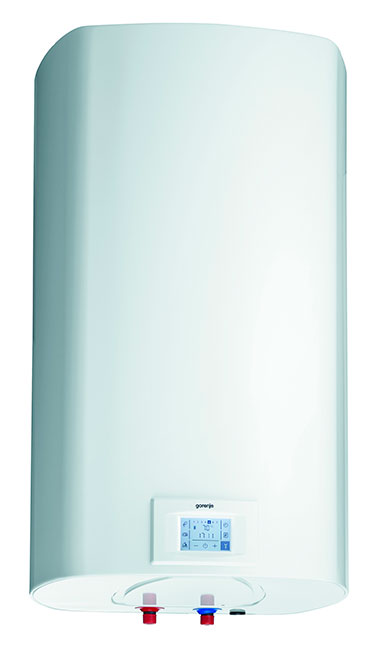
The indirect heating boiler does not have its own power source - it uses the energy produced by the boiler for the heating system.
The structure includes: a warmed storage tank with a surface that is anticorrosive from the inside; periodically replaced anode; predominantly brass serpentine heat exchanger; security group; 2 inlets and outlets for circulating coolant and cold / hot water.
The principle of operation is based on the tie-in of the equipment into the closed heating circuit: the coolant flows from the boiler, one part of which goes to the radiators, the second to the boiler to heat the water then to the sink, sink, bath and shower.
Connection includes many nuances: the wiring can have different versions; on the inlet branch to the heat exchanger, a loading pump and a check valve are installed; A tank with a capacity of ≈ 100 ... 300 l is mounted near the boiler, and, as a rule, in the utility room.
Advantages of indirect heating boilers:
- high performance and low cost of hot water;
- the ability to feed in large quantities to different points of analysis;
- after opening the tap, hot water flows immediately;
- availability of additional energy use of electricity, sun and gas;
- slow cooling - no more than 4 ° C per day;
- simplicity of design and use.
Disadvantages:
- overall high cost and bulkiness of equipment;
- heating time;
- heat extraction, albeit insignificant, from the heating system.
Many models of modern boilers have an improved design that allows you to connect alternative energy sources - they are called combined. After the heating season, really use electricity or gas. Are not strange and devices, additionally functioning from solar panels.
- See also: best indirect heating boilers
Water heater selection parameters
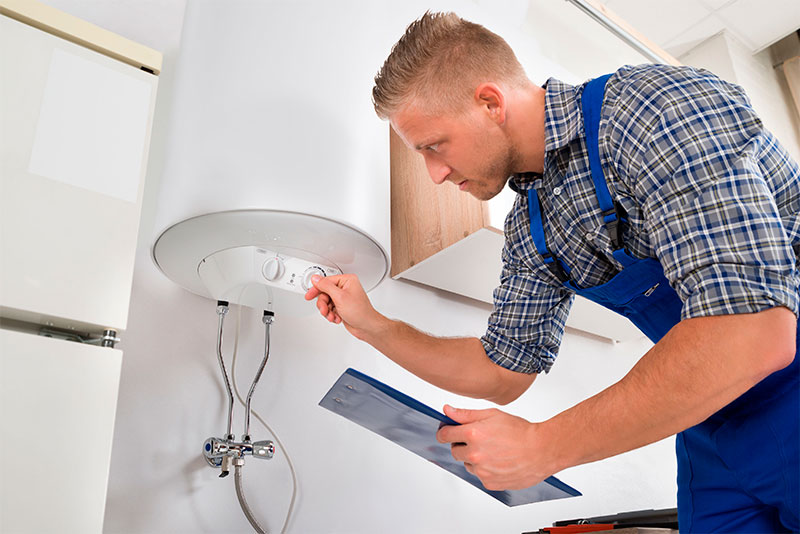
Before buying a product, specific needs for hot water are determined, namely: consumption volumes based on the number of users and points of analysis, as well as the mode of operation.
Then select the characteristics of the device, the main ones among which are: type, power, capacity and performance; shape, design and material; control methods, control and installation.
The separation is carried out according to 3 signs: according to the method of heating, the devices differ in flow and storage; by type of energy carrier - electrical, gas and indirect; conditionally for domestic purposes - for a private house, for an apartment, to give. Dishwashing requires up to 30 liters of water, for morning hygiene - no more than 15 liters, for taking a shower - about 80 liters, for bathing in a bath - about 150 liters.
1. Electric storage water heater
When choosing a tank, the following is taken into account: a volume of about 30 liters is designed for 1 distribution point and 1 person, at least 150 liters for 5 tr. and 5 people; the inner coating is enamel, glass-ceramic, titanium, stainless steel (the latter two are more preferable); thermal insulation is made of foam rubber, polyurethane foam, mineral wool (the first is the least effective).
The selection also takes into account the regularity: the larger the tank (usually 10 ... 300 l) and less power (usually 1 ... 2.5 kW), the heating time increases - up to 3 ... 4 hours. The process can be accelerated with 2 heating elements, which are “dry” and “wet” - the former are not in contact with the liquid, therefore they serve longer.
In addition, the purchase takes into account equipment automation and installation method - on the wall (up to 120 liters) or on the floor (150 liters).
2. Gas storage water heater
This device is similar in design to the previous one, but in the “stuffing” there are cardinal differences, so other parameters are also selectable.
The combustion chamber can be open and closed (the first is more popular); ignition differs piezoelectric, electronic, hydrodynamic; power is usually 4 ... 9 kW.
Since the "blue" fuel is explosive, with the purchase, the completeness of the security system is checked: a hydraulic valve, a thrust sensor, a flame controller. When choosing in favor of this unit, you need to understand that gas is relatively cheap, but installation will be expensive.
3. Electric instantaneous water heater
It is a powerful compact device that is mounted on the wall. When choosing, it is necessary to take into account: with a power up to 8 kW, the device operates from a single-phase network of 220 V, which is mainly present in apartments. With more power, it is connected to the wiring for 3 phases of 380 V, which is usually operated in private homes.
With a slight performance (2 ... 4 l / min), the product is excellent for summer houses.
4. Gas flow water heater
The so-called column is installed both in houses and apartments - it supplies uninterruptedly a different number of collapsible points.
When buying, you need to proceed from the calculation: at 17 kW, the capacity will be up to 10 l / min, and this is enough only for a sink or shower; 25 kW (≈ 13 l / min) is enough for 2 points of analysis; more than 30 kW (˃ 15 l / min) will ensure the supply of warm water to several mixers.
5. Indirect heating boiler is mainly installed in country houses - it uses the energy of the heating system and does not depend on electricity or gas.
In essence, it is a storage tank with a capacity of 100 ... 300 liters, which is installed near the boiler. When choosing this unit, you need to accurately determine the volume, because when it is too large, the heating process is unjustifiably slowed down.
It is advisable to purchase the device in a design that allows to connect the heating elements for the summer season. In addition, it is necessary to pay attention to the warranty period, appearance and cost.
Which water heater to choose

1. Instantaneous water heater
If hot water interruptions occur frequently, electric flow-through devices, which are installed in a variety of residential, administrative, commercial and industrial facilities, will effectively help out.
The most pragmatic applications: at the dacha - a pressure-free model with a capacity of 3.5 ... 4.0 kW per 1 folding point for hygienic and household needs; in the apartment - pressure version (6.0 ... 8.0 kW) for washing or shower; in a private house - pressure version (up to 20.0 kW) for 2 sanitary appliances in the kitchen and bathroom. The last example is feasible in the presence of a three-phase wiring voltage of 380 V.
If the region’s gas supply is at a high level and an economic component in favor of “blue” fuel, columns are installed - to fully supply the house or apartment with hot water it will be necessary from 30 kW, corresponding to at least 15 l / min. For giving it is possible to use cylinders with propane.
2. Accumulative water heater
Electric appliances of accumulative type heat water relatively slowly, but in large volumes.
A product (with 2 electric heating elements of 2 kW each) with a capacity of 10 ... 50 l per person is suitable for a house or apartment; 30 ... 80 l - for 2 people; 80 ... 150 l for a family with 1, 2 or 3 children. With more consumers and plumbing fixtures, as well as with dense water consumption, tanks from 200 liters are used.
An alternative to these devices - gas storage devices, which are installed in the presence of an appropriate highway and economic justification.
In the apartments, wall-mounted models of up to 120 liters for 4 ... 6 kW are used, in country houses - floor-standing versions up to 300 liters for 7 ... 9 kW. In addition, in the second case, unlike the first, it is possible to use both an open combustion chamber in combination with a chimney, and a closed burner with a coaxial pipe exiting through a wall.
3. Indirect heating boiler
The indirect heating boiler, being a cumulative modification, is usually installed in homes equipped with an autonomous heating system, inclusive of a boiler — the appliance is suitable for such objects in a wall-mounted or outdoor version with a capacity of 100 to 300 liters.
Since the device depends on the functioning of the heating, it is economically “attractive” only in the autumn-spring season, which means that it is more advisable to buy a combined modification, additionally equipped with heating elements or a heat exchanger, for example, under a solar panel.
In this case, 2 different water heating circuits will work alternately or, if necessary, together. The choice of an alternative source of energy depends on many factors, among which the economic benefit is in the first place.
How much is the water heater
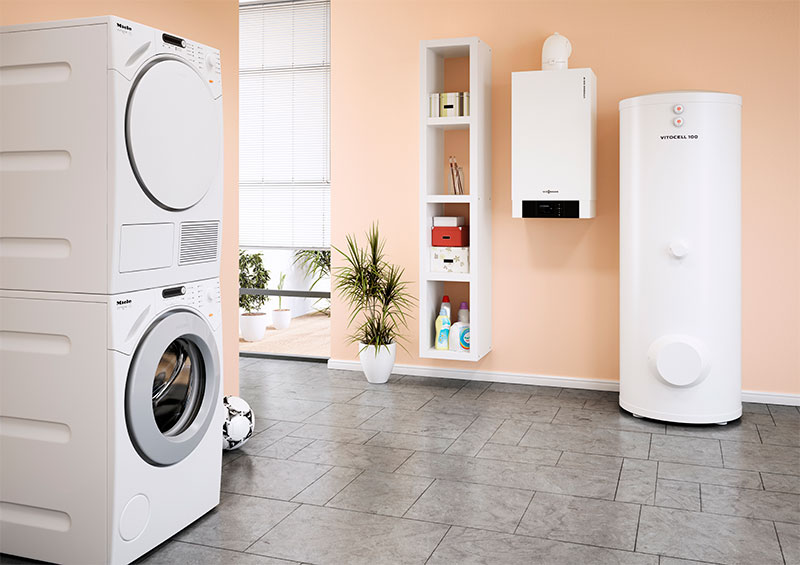
One of the most important selection criteria is the price, which depends on the model, the quality of the materials used, the technical characteristics, the place of assembly and the name of the manufacturer:
1. Suitable for summer cottage: Timberk WHEL-3 OSC - electric flow with spout and shower head (power consumption 3500 W, capacity 1.9 l / min) 2.4 ... 2.9 thousand rubles.
2. Suitable for the apartment: Bosch 13-2G - gas flow with an open chamber and hydrodynamic ignition (22600 W, 13 l / min). 15.0 ... 16.4 thousand rubles; Gorenje GBFU 100 E B6 - electric storage with 2 dry heating elements (2000 W, 100 l). 13.5 ... 15.3 thousand rubles.
3. Suitable for private homes: Electrolux NPX 8 Flow Active - electric flow-through with electronic control (8800 W, 4.2 l / min). 13.5 ... 14.7 thousand rubles; Baxi Premier plus 200 - indirect combined type with the ability to install heating elements (30000 W, 200 l, 12.3 l / min). 41.6 ... 52.2 thousand rubles.
Prices are relevant for Moscow and the region as of 2017.
It will be interesting to friends too




